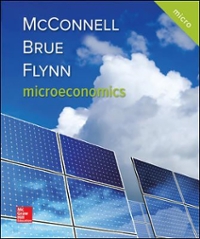Question
The Economic Stimulus Act of 2008 and the American Economic Recovery and Reinvestment Act of 2009 where the latest big experiments the U.S. has undertaken
The Economic Stimulus Act of 2008 and the American Economic Recovery and Reinvestment Act of 2009 where the latest big experiments the U.S. has undertaken with large-scale fiscal stimulus. Recall that the purpose of fiscal stimulus is to increase either AD or AS with some combination of government spending or tax cuts. John Taylor is a prominent critic of this type of stimulus. The reading below is not an article, but Congressional testimony Taylor gave to the Committee on Oversight and Government Reform. In it, he provides some arguments for why the ARRA was not effective in stimulating growth or reducing unemployment following the Great Recession. Read pages 1-6 then answer the following questions:
john taylor 2009-Stimulus-two-years-later.pdf (pages 1-6 posted below)
1. The ARRA of 2009 and the ESA of 2008 are described as "Keynesian" fiscal stimulus bills. Why?
2. What were the spending components of the ARRA, as described by Taylor? What percentage of the total spending in the ARRA went to each component? Is this information surprising to you in light of what you know about how the spending multiplier works?
3. This question is closely related to #2. Why where federal income transfers to the states ineffective as stimulus efforts?
The 2009 Stimulus Package: Two Years Later
John B. Taylor*
Testimony Before the
Committee on Oversight and Government Reform
Subcommittee on Regulatory Affairs, Stimulus Oversight and Government Spending
U.S. House of Representatives
February 16, 2011
Chairman Jordon, Ranking Member Kucinich, and other members of the Committee,
thank you for the opportunity to testify on the impact of the American Recovery and
Reinvestment Act (ARRA) of 2009, enacted two years ago this week.
My empirical research during the past two years shows that ARRA did not have a
significant impact in stimulating the economy.1 I do not think this finding should come as a
surprise. Earlier research on the discretionary countercyclical Economic Stimulus Act of 2008?
enacted three years ago this week?indicates that it too did little to stimulate the economy.2
Research on the discretionary countercyclical actions in the late 1960s and 1970s?the most
recent period of such large interventions prior to this past decade?also shows disappointing
results, including high unemployment, high inflation, high interest rates, and frequent recessions;
the poor results of the 1970s policies led top macroeconomists to write influential papers, such as
"After Keynesian Macroeconomics," which questioned the whole approach and to decry "that
countercyclical discretionary fiscal policy is neither desirable nor politically feasible." 3
My purpose here today is not to explain this recent revival of a failed approach to policy,
but rather to summarize the facts which once again raise doubts about its effectiveness. I take a
macroeconomic perspective, looking at the impact of ARRA on the major components of GDP,
such as government purchases and consumption expenditures. Changes in GDP are of course
directly related to employment growth, with faster growth of GDP creating more jobs. I make
use of a new data set developed by the Bureau of Economic Analysis (BEA) at the Department
of Commerce which traces the impact of ARRA on the economy through the National Income
and Product Accounts, the major source of data for macroeconomic analysis. I present and
analyze the data through a series of simple graphs, but the findings can be verified and supported
through statistical analysis.
* Mary and Robert Raymond Professor of Economics at Stanford University and George P. Shultz Senior
Fellow in Economics at Stanford University's Hoover Institution
1 Much of this research has been conducted jointly; see for example Cogan, Cwik, Taylor and Wieland
(2010), Cogan and Taylor (2010), Taylor (2010), and Taylor (2011)
2 Taylor (2009)
3 Examples of papers on temporary tax cuts and countercyclical grants to states are Blinder (1981) and
Gramlich (1979), respectively; the paper about after Keynesian macroeconomics is by Lucas and Sargent
(1978) and the quote is from Eichenbaum (1997)
2
The Major Macroeconomic Components of ARRA
The bar chart below summarizes the impact of ARRA on federal government sector
transactions during the two years or eight quarters since enactment.4 Three components of
ARRA are highlighted:
(1) Federal government purchases of goods and services (both government
consumption and government investment),
(2) Federal grants to states and local governments, and
(3) Temporary transfers and credits which increase the disposable personal
income of individuals and families.
For the purposes of assessing the impact of ARRA on the economy it is very important to
distinguish between these three categories and consider each in turn. 5
4 The data are from the BEA table "The Effect of the ARRA on Selected Federal Government Sector
Transactions" posted on the BEA webpage.
5 A small part of ARRA?not shown in the bar chart?was classified as going to the business sector in the
form of subsidies and tax benefits, for example for renewable energy or first time home buyers credits,
which I do not consider in this testimony. It should also be emphasized that ARRA is one of many other
fiscal interventions during the past two years, including the cash-for-clunkers program and an unusually
large increase in appropriated funds not officially counted as part of ARRA. See Anderson (2011) for
details.
Part B.


Step by Step Solution
There are 3 Steps involved in it
Step: 1

Get Instant Access to Expert-Tailored Solutions
See step-by-step solutions with expert insights and AI powered tools for academic success
Step: 2

Step: 3

Ace Your Homework with AI
Get the answers you need in no time with our AI-driven, step-by-step assistance
Get Started


